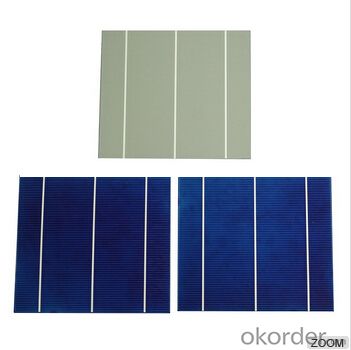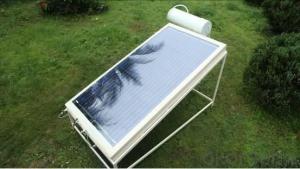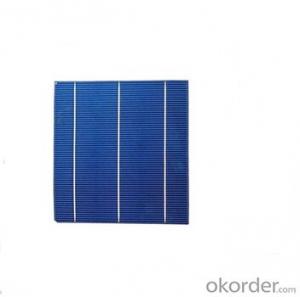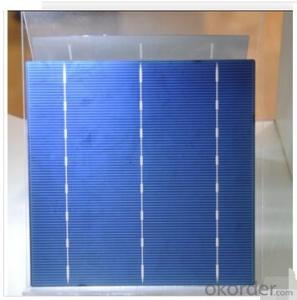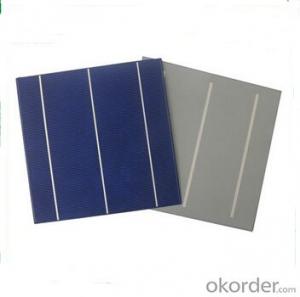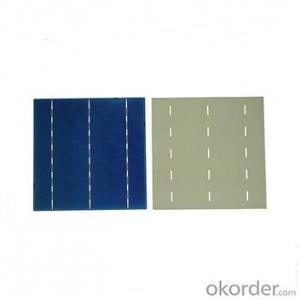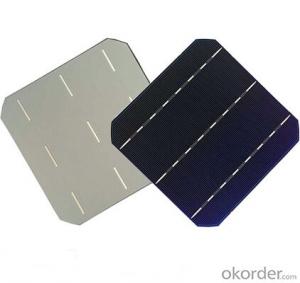High Quality Hydrocarbon Polycrystalline Solar Cells 16.80-18.00 Effy
- Loading Port:
- Shanghai
- Payment Terms:
- TT or LC
- Min Order Qty:
- 1000 pc
- Supply Capability:
- 1000000 pc/month
OKorder Service Pledge
OKorder Financial Service
You Might Also Like
Solar Cells:
solar cells, when struck by photons of light from the sun, generates an electrical current which can then be used to power DC or AC electrical loads.
A solar cell is made of silicon. Computer chips are made of this same material. Basically, when light strikes the surface of a solar cell some of it is absorbed into the silicon. This light energy bumps the electrons loose and causes energy to flow
Solar cells is made by solar wafer, it has three categories of solar cell right now, monocrystalline polycrystalline and thin film,These cells are entirely based around the concept of PN junction, which is the critical part of solar module, it is the part that can convert the light energy into electricity, the thickness is from 180um to 200um, with even busbars to conduct electricity, textured cell can decrease diffuse reflection; they are often electrically connected and encapsulated as a module. Photovoltaic modules often have a sheet of glass on the front (sun up) side, allowing light to pass while protecting semiconductor wafers from abrasion and impact due to wind-driven debris, rain, hail, etc. Solar cells are also usually connected in series in modules, creating an additive voltage. Connecting cells in parallel will yield a higher current;With high quality and stable quality. Our Cells can greatly improve the performance of Solar Modules.
Specifications
Efficiency(%) | 18.00 | 17.80 | 17.60 | 17.40 | 17.20 | 16.80 |
Pmpp(W) | 4.33 | 4.29 | 4.24 | 4.19 | 4.14 | 4.09 |
Umpp(V) | 0.530 | 0.527 | 0.524 | 0.521 | 0.518 | 0.516 |
Impp(A) | 8.159 | 8.126 | 8.081 | 8.035 | 7.990 | 7.938 |
Uoc(V) | 0.633 | 0.631 | 0.628 | 0.625 | 0.623 | 0.620 |
Isc(A) | 8.709 | 8.677 | 8.629 | 8.578 | 8.531 | 8.478 |
Solar Cells Advantage:
• High efficiency and stable performance in photovoltaic conversion.
• Advanced diffusion technique ensuring the homogeneity of energy conversion efficiency of the cell.
• Advanced PECVD film forming, providing a dark blue silicon nitride anti-reflection film of homogenous color and attractive appearance.
• High quality metal paste for back surface and electrode, ensuring good conductivity, high pulling strength and ease of soldering.
• High precision patterning using screen printing, ensuring accurate busbar location for ease with automatic soldering a laser cutting.
Features:
1. High conversion efficiencies resulting in superior power output performance
2. Outstanding power output even in low light or high temperature conditions
3. Optimized design for ease of soldering and lamination
4. Long-term stability, reliability and performance
5. Low breakage rate
6. Color uniformity

FAQ
We have organized several common questions for our clients,may help you sincerely:
①What price for each watt?
It depends on the efficiency of the solar cell, quantity, delivery date and payment terms.
②How long can we receive the product after purchase?
In the purchase of product within three working days, We will arrange the factory delivery as soon as possible. The pecific time of receiving is related to the state and position of customers.Commonly 7 to 10 working days can be served.
③Can you provide the peripheral products of the solar panels, such as the battery, controller, and inverter? If so, can you tell me how do they match each other?
Yes, we can, we have two companies for solar region, one is CNBM International, the other is CNBM engineering Co.
We can provide you not only the solar module but also the off grid solar system, we can also provide you service with on grid plant.
④What is your warranty of solar cell?
Our product can promise lower than 0.3% open box crack, we support claim after opening the box if it has crackm color difference or sth, the buyer should give pictures immediately, we can not accept the claim after the solar cell has assembled to solar panel.
• Timeliness of delivery
• ⑤How do you pack your products?
We have rich experience on how to pack the solar cell to make sure the safety on shipment, we could use wooden box or pallet as buyer's preference.
How to Make Solar Cell in Home
Solar cells have a huge usage in home. If you want to get a solar cell at home, you can light up your little things like a clock, radio, etc. And here some steps to make solar cells . First, take a copper sheet and cut it into equal parts. After cutting, you have 2 pieces of the same size. Step2: Heat up one piece of copper sheet completely using a burner or gas stove. Heat up 20 to 30 minutes. Then place it undisturbed to cool down. Step3: Attach a piece of copper wire to it. Clear that place where you will attach copper wire to it. Step 4: Take another piece of copper sheet and attach it to another piece of copper wire. Step5: Take a plastic bottle and cut it half. In the bottom part of bottle make a solution of hot water and salt. Step6: Paste burned copper sheet in the bottle. Only copper sheet touched with water not copper wire. Step7: In opposite direction paste another piece of copper sheet. Step8: Now your solar cell is ready to be attached to anything to the wire which is attached to copper sheets.
How to Build your own Solar Cell
Step 1: Stain the Titanium Dioxide with the Natural Dye: Stain the white side of a glass plate which has been coated with titanium dioxide (TiO2). This glass has been previously coated with a transparent conductive layer (SnO2), as well as a porous TiO2 film. Crush fresh blackberries, raspberries, pomegranate seeds, or red Hibiscus tea in a tablespoon of water. Soak the film for 5 minutes in this liquid to stain the film to a deep red-purple color. If both sides of the film are not uniformly stained, then put it back in the juice for 5 more minutes. Wash the film in ethanol and gently blot it dry with a tissue.
Step 2: Coat the Counter Electrode: The solar cell needs both a positive and a negative plate to function. The positive electrode is called the counter electrode and is created from a "conductive" SnO2 coated glass plate. A Volt - Ohm meter can be used to check which side of the glass is conductive. When scratched with a finger nail, it is the rough side. The "non-conductive" side is marked with a "+." Use a pencil lead to apply a thin graphite (catalytic carbon) layer to the conductive side of plate's surface.
Steps 3: Add the Electrolyte and Assemble the Finished Solar Cell: The Iodide solution serves as the electrolyte in the solar cell to complete the circuit and regenerate the dye. Place the stained plate on the table so that the film side is up and place one or two drops of the iodide/iodine electrolyte solution on the stained portion of the film. Then place the counter electrode on top of the stained film so that the conductive side of the counter electrode is on top of the film. Offset the glass plates so that the edges of each plate are exposed. These will serve as the contact points for the negative and positive electrodes so that you can extract electricity and test your cell. Use the two clips to hold the two electrodes together at the corner of the plates. The output is approximately 0.43 V and 1 MA /cm2 when the cell is illuminated in full sun through the TiO2 side.
- Q: Can solar cells be used in powering electric boats?
- Yes, solar cells can be used to power electric boats. Solar panels can convert sunlight into electricity, which can then be used to charge the batteries of electric boats. This renewable energy source is clean, sustainable, and can help reduce carbon emissions from boating activities.
- Q: How long does it take for solar cells to pay for themselves?
- The payback period for solar cells can vary widely depending on factors such as the initial cost of the system, local energy prices, available incentives, and the amount of electricity generated. On average, it can take anywhere between 5 to 15 years for solar cells to pay for themselves through energy savings and potential government incentives.
- Q: What is the impact of hurricane-force winds on solar cell efficiency?
- The impact of hurricane-force winds on solar cell efficiency can be significant. Strong winds can cause physical damage to the solar panels, such as cracks or detachment, which can reduce their ability to generate electricity. Additionally, debris carried by the winds may also damage the panels, further decreasing their efficiency. Therefore, it is crucial to ensure proper installation and structural resilience to mitigate the negative effects of hurricane-force winds on solar cell efficiency.
- Q: What is the role of solar cells in powering traffic signals?
- Solar cells play a crucial role in powering traffic signals as they convert sunlight into electricity, which is then used to operate the signals. By harnessing renewable energy, solar cells eliminate the need for grid connection or reliance on fossil fuels, making traffic signals more sustainable and cost-effective.
- Q: Where can I find more information about the work process of solar cells
- Some scientific books specifically talk about how solar cells work in an accurate way.
- Q: What is the most commonly used material for solar cells?
- In terms of energy conversion efficiency and sustainability, the silicon and polycrystalline silicon cells are superior to amorphous silicon cells. Polycrystalline silicon conversion efficiency is low, but the price is cheaper.
- Q: How do solar cells perform in dry desert conditions?
- Solar cells perform exceptionally well in dry desert conditions. The intense sunlight and lack of humidity in desert environments create optimal conditions for the generation of solar energy. The absence of clouds and minimal air pollution allows solar cells to efficiently convert sunlight into electricity, resulting in higher energy output. Additionally, the heat in desert regions can increase the efficiency of solar cells, as their performance typically improves with higher temperatures. Therefore, solar cells are highly effective and efficient in dry desert conditions.
- Q: Is the Photovoltaic cell panel good to save the energy?
- The Photovoltaic cell panel is actually very much developed for saving the energy. After several years of research and development, the third generation solar cells (including various semiconducting properties at the molecular level of the material) has already being used.
- Q: What is the impact of bird droppings or debris on solar cell performance?
- Bird droppings or debris on solar cell panels can significantly impact their performance. The droppings can create a layer that blocks sunlight from reaching the cells, reducing their efficiency in converting solar energy into electricity. Additionally, the debris can accumulate over time and create shadows on the panels, further decreasing their output. Regular cleaning and maintenance of solar panels are essential to maximize their performance and ensure optimal energy production.
- Q: Can solar cells be used for powering traffic lights?
- Yes, solar cells can be used for powering traffic lights. Solar panels can harness sunlight and convert it into electricity, providing a sustainable and renewable source of power for traffic lights. This eliminates the need for traditional electrical grid connections and reduces carbon emissions. Solar-powered traffic lights are increasingly being adopted as an eco-friendly and cost-effective solution in many locations around the world.
Send your message to us
High Quality Hydrocarbon Polycrystalline Solar Cells 16.80-18.00 Effy
- Loading Port:
- Shanghai
- Payment Terms:
- TT or LC
- Min Order Qty:
- 1000 pc
- Supply Capability:
- 1000000 pc/month
OKorder Service Pledge
OKorder Financial Service
Similar products
Hot products
Hot Searches
Related keywords



